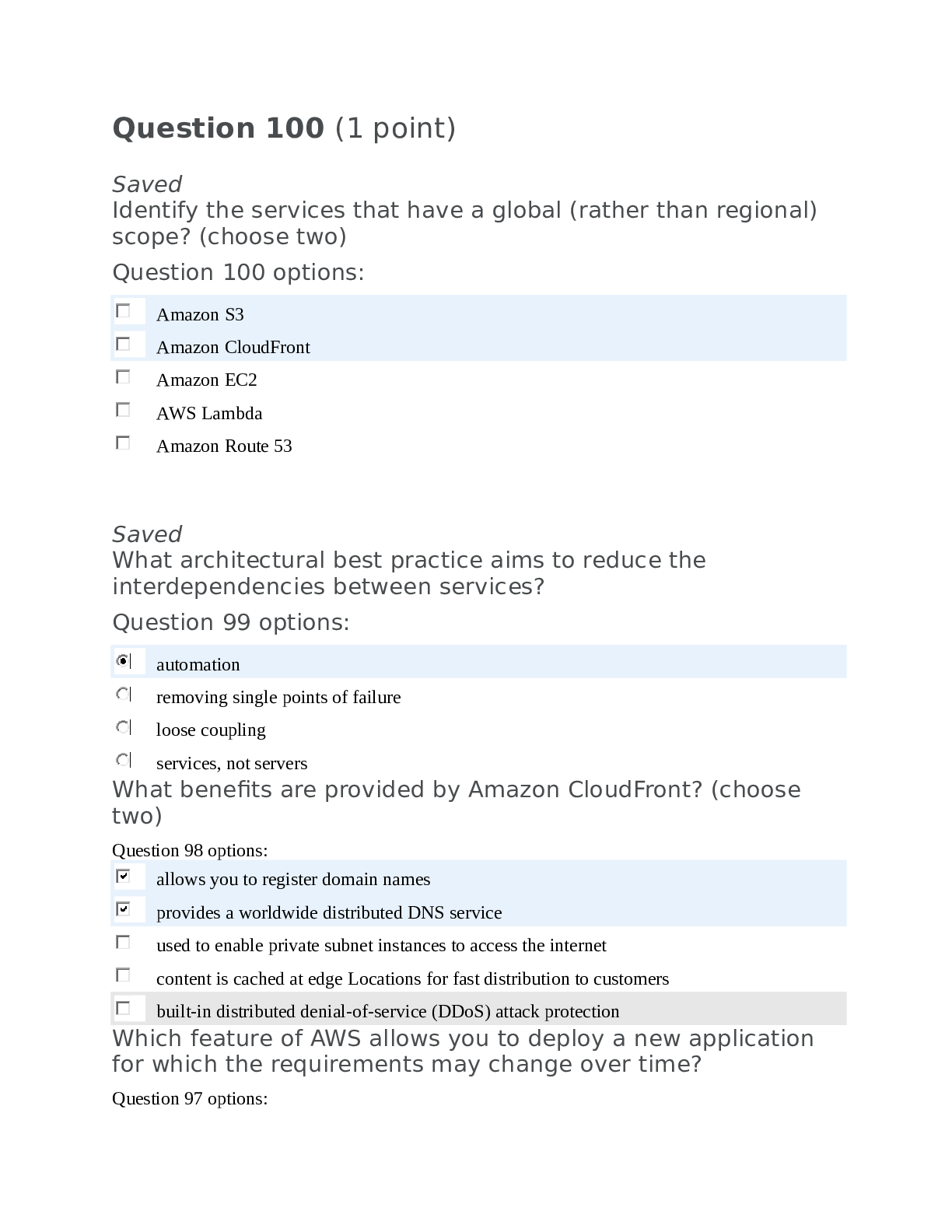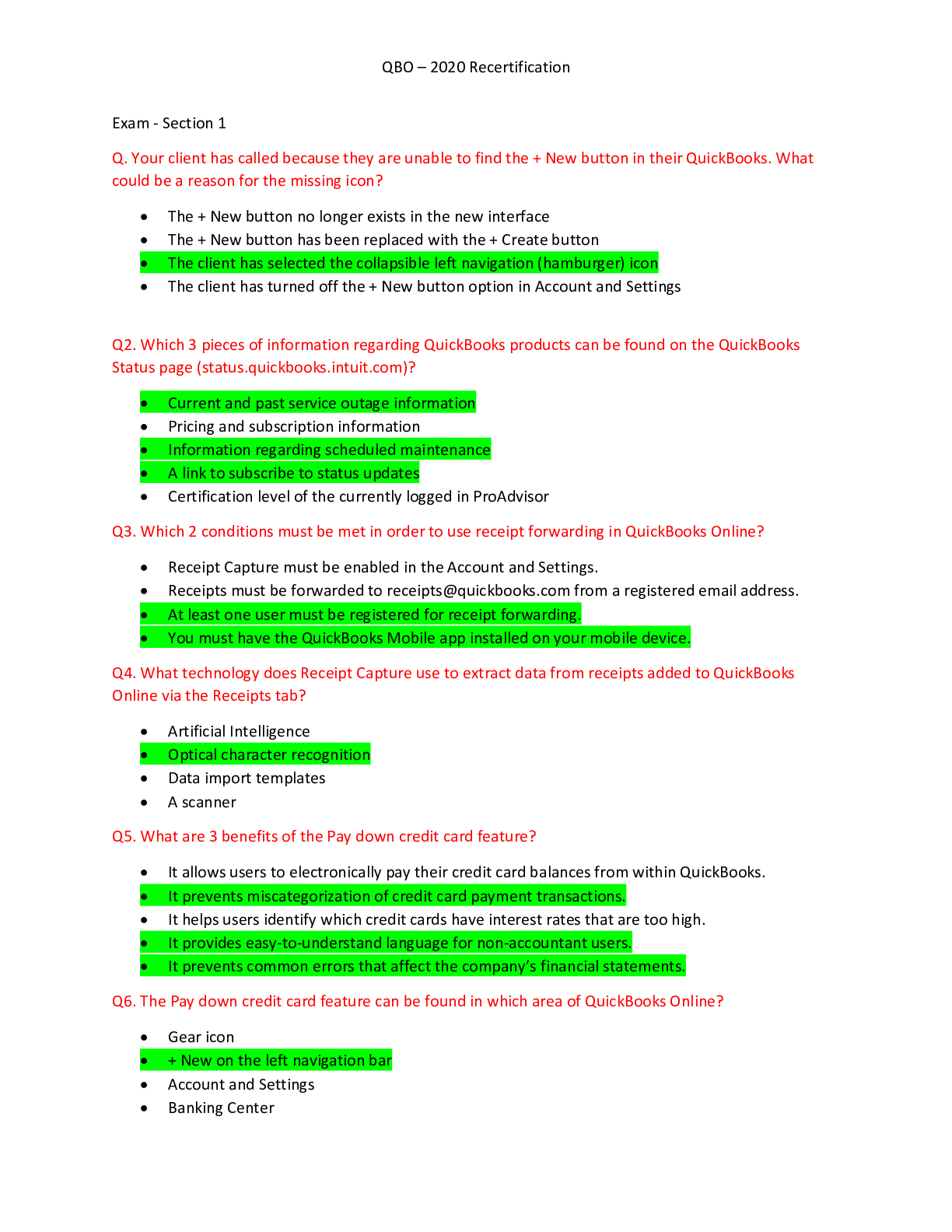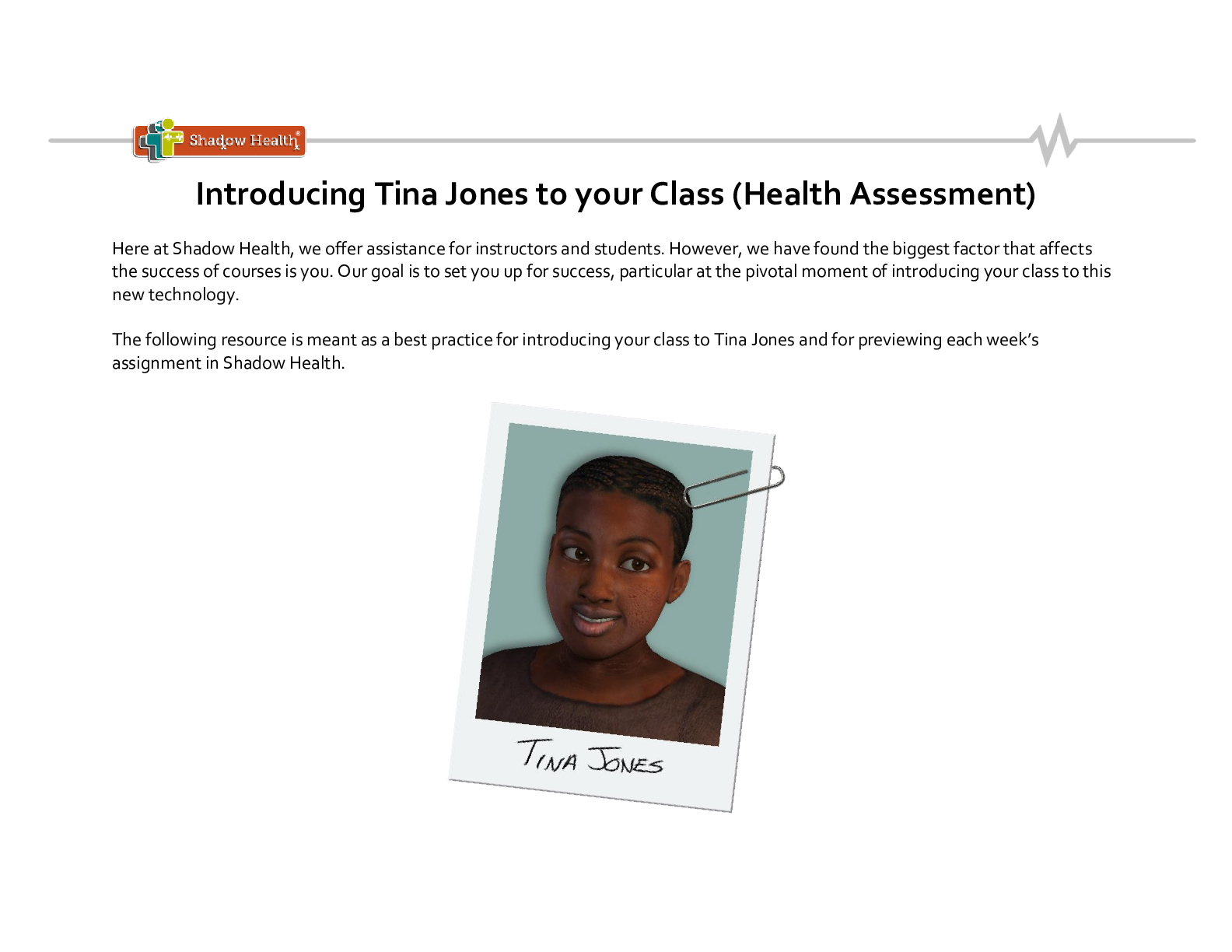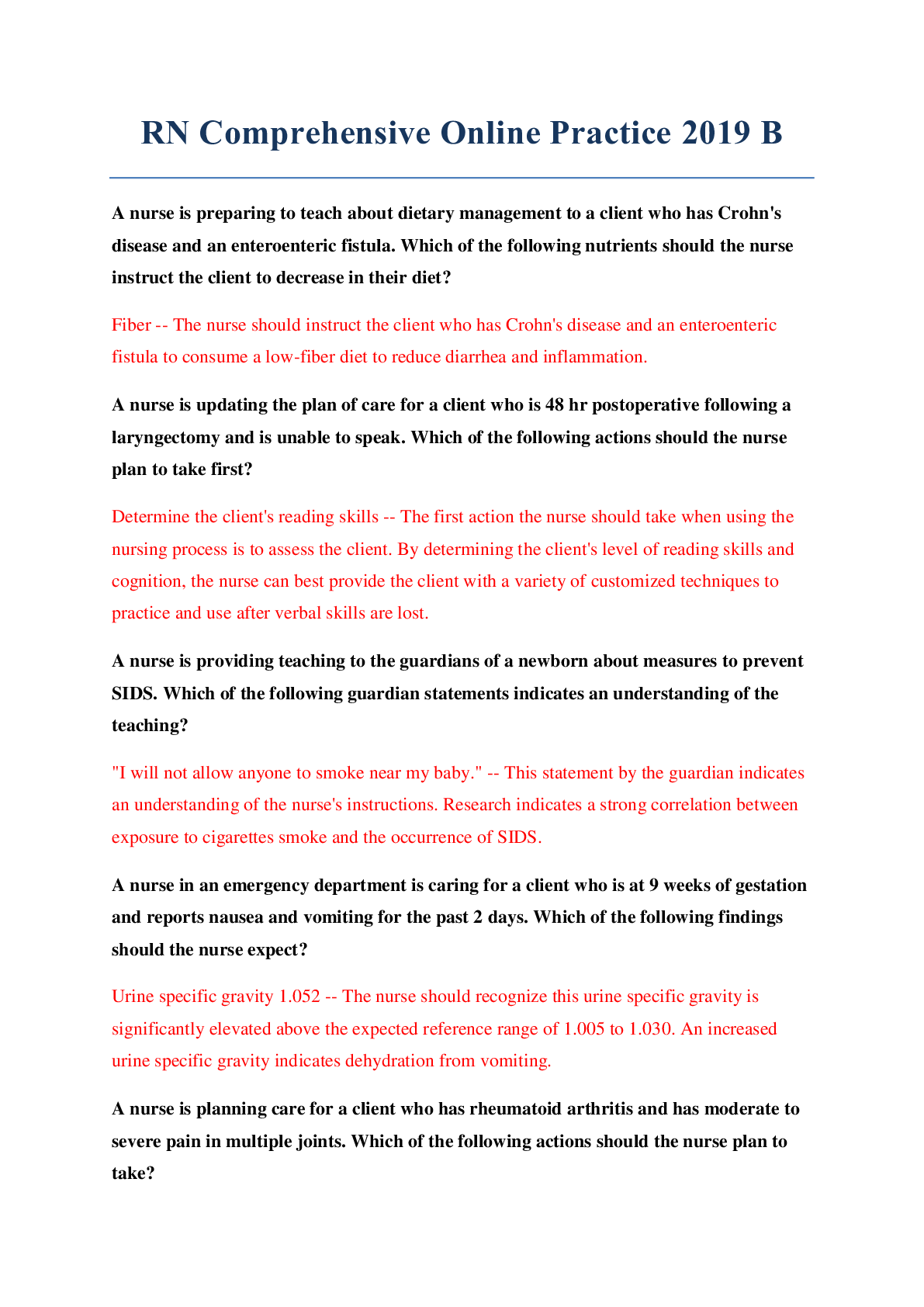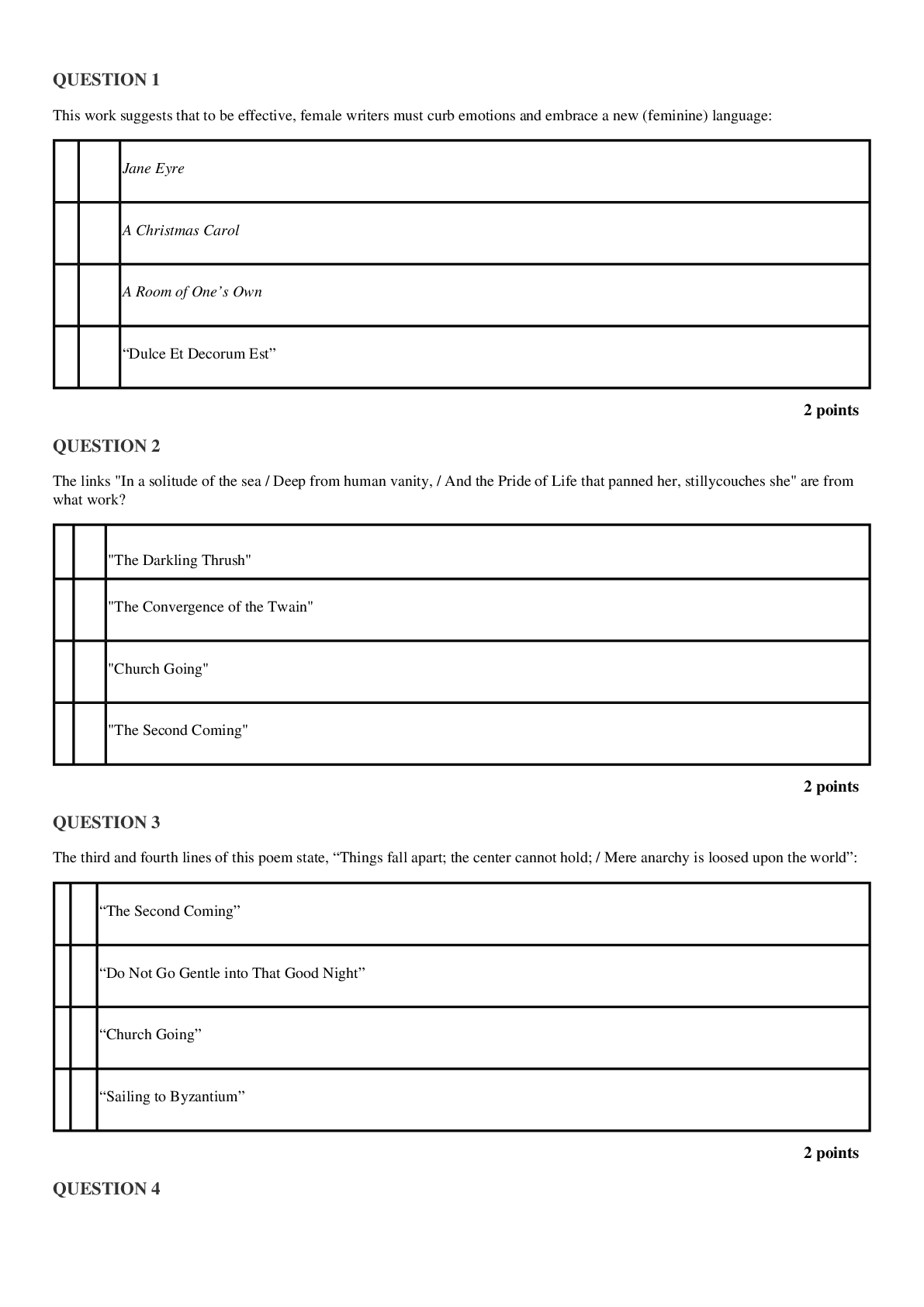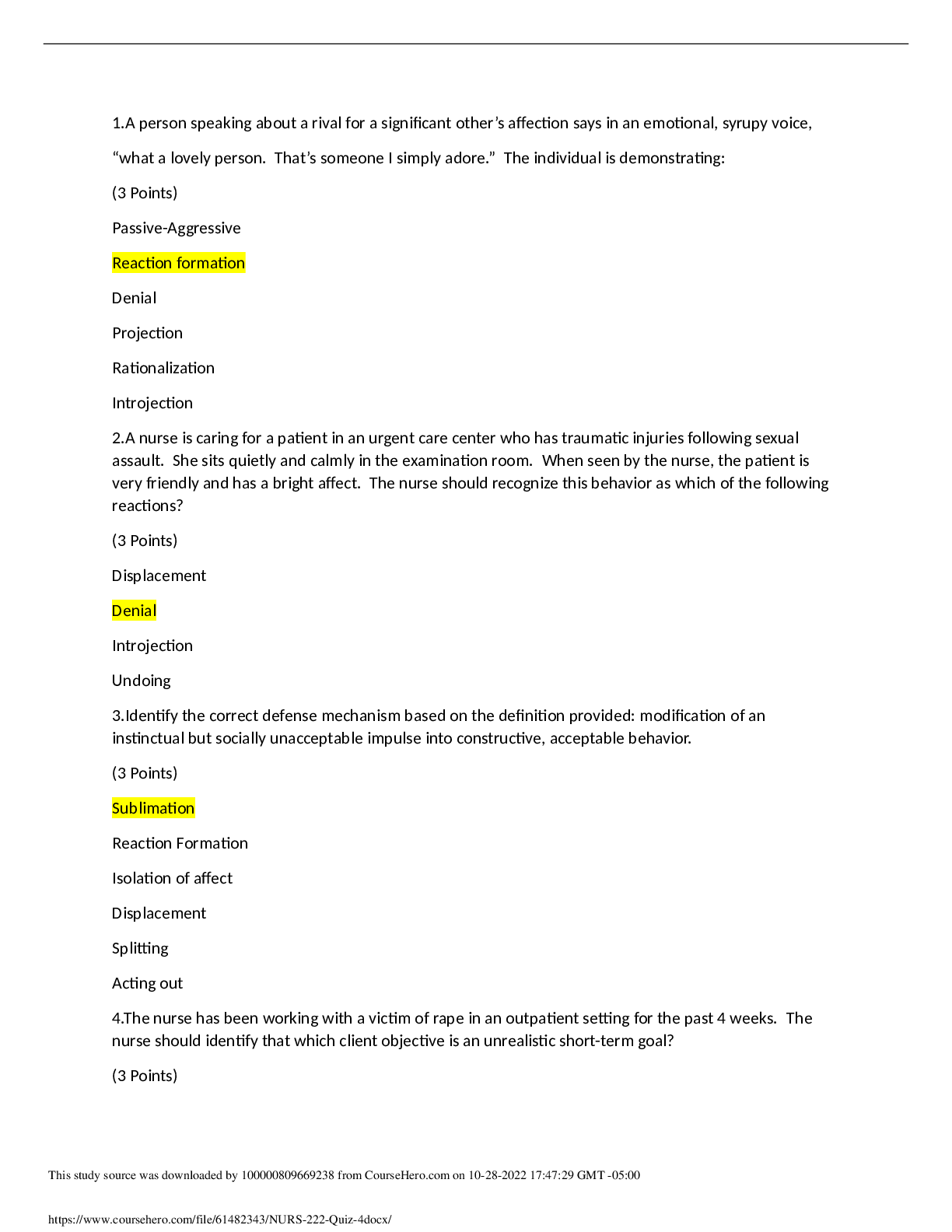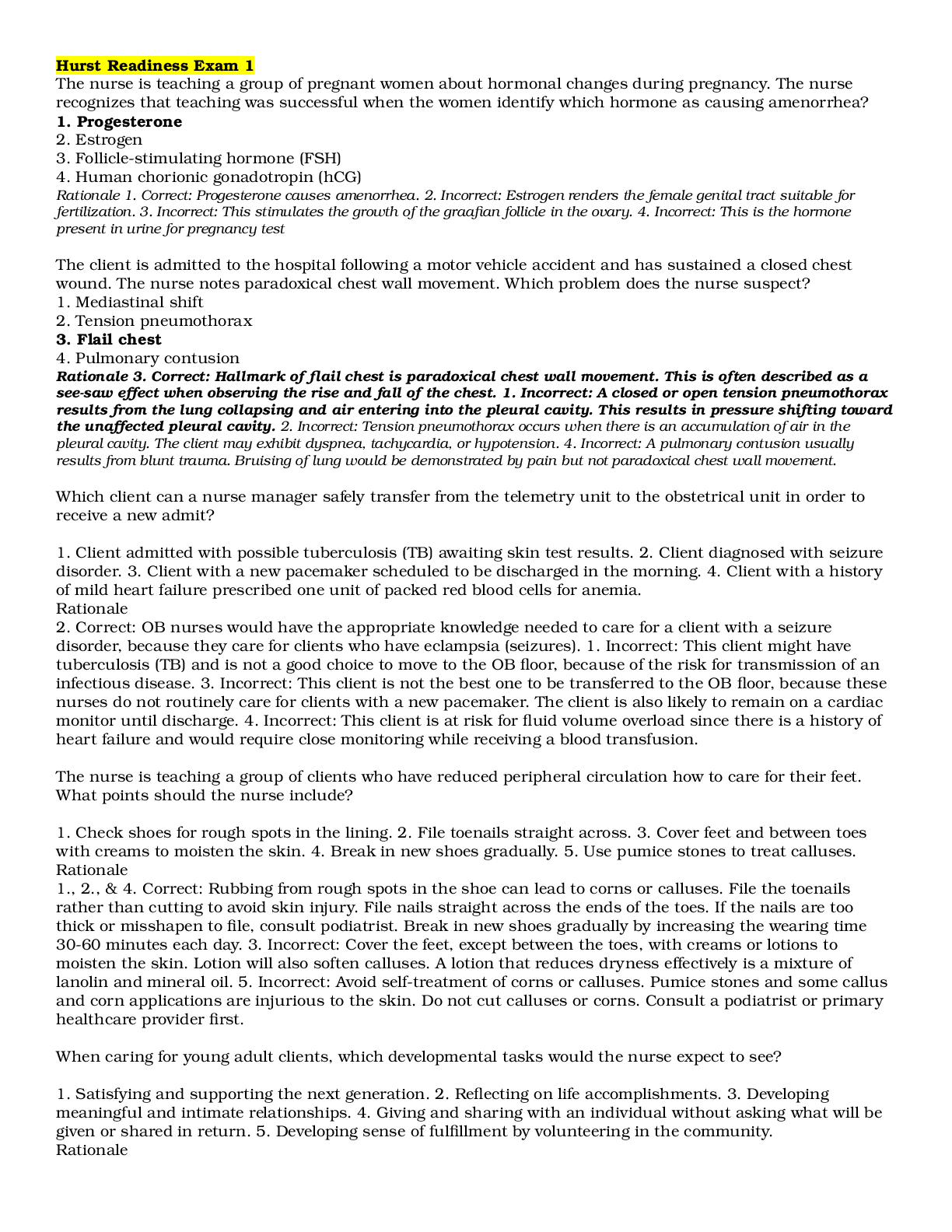Financial Accounting > EXAM > Cost Accounting 101: Exam chapter 4, questions and answers. All Solutions Worked. (All)
Cost Accounting 101: Exam chapter 4, questions and answers. All Solutions Worked.
Document Content and Description Below
lOMoARcPSD|784381 Cost Accounting 101: Exam chapter 4, questions and answers CHAPTER 4 JOB COSTING 4-1 Define cost pool, cost tracing, cost allocation, and cost-allocation base. 4-2 Wh... at is the main difference between job costing and process costing? Provide one example for each costing method. 4-3 Why might an advertising agency use job costing for an advertising campaign by PepsiCo, whereas a bank might use process costing to determine the cost of checking account deposits? 4-4 Explain how you can determine the cost of a cost object/job under job-costing system. 4-5 Give examples of two cost objects in companies using job costing. 4-6 Describe three major source documents used in job-costing systems. 4-7 What is the role of information technology in job costing? 4-8 Seasonal patterns and fluctuating levels of monthly outputs are the two main factors for most organizations to use an annual period rather than a weekly or a monthly period to compute budgeted indirect-cost rates. Explain how annual indirect rates alleviate the impacts of these two factors. 4-9 Distinguish between actual costing and normal costing. 4-10 Explain how job-costing information may be used for decision making. 4-11 Comment on the following statement: There is no difference between ―actual costing‖ and ―normal costing‖ systems as both use the product of actual direct-cost rates and actual quantities of direct- cost inputs. EA 4-12 Describe the flow of costs in a normal job-costing system. 4-13 Describe three alternative ways to dispose of under- or overallocated overhead costs. 4-14 When might a company use budgeted costs rather than actual costs to compute direct- labor rates? 4-15 Describe briefly why Electronic Data Interchange (EDI) is helpful to managers. 4-16 Which of the following does not accurately describe the application of job-order costing? a. Finished goods that are purchased by customers will directly impact cost of goods sold. b. Indirect manufacturing labor and indirect materials are part of the actual manufacturing costs incurred. c. Direct materials and direct manufacturing labor are included in total manufacturing costs. d. Manufacturing overhead costs incurred is used to determine total manufacturing costs. 4-17 Sturdy Manufacturing Co. assembled the following cost data for job order #23: What are the total manufacturing costs for job order #23 if the company uses normal job-order costing? a. $191,500 b. $193,500 c. $194,500 d. $195,500 4-18 For which of the following industries would job-order costing most likely not be appropriate? a. Small business printing. b. Cereal production. c. Home construction. d. Aircraft assembly. 4-19 ABC Company uses job-order costing and has assembled the following cost data for the production and assembly of item X: Based on the above cost data, the manufacturing overhead for item X is: a. $500 overallocated. b. $600 underallocated. c. $500 underallocated d. $600 overallocated. 4-20 Under Stanford Corporation‘s job costing system, manufacturing overhead is applied to work in process using a predetermined annual overhead rate. During November, Year 1, Stanford‘s transactions included the following: Stanford had neither beginning nor ending work-in-process inventory. What was the cost of jobs completed and transferred to finished goods in November 20X1? Required: 1. $604,000 2. $644,000 3. $620,000 4. $660,000 4-21 (10 min) Job costing, process costing. In each of the following situations, determine whether job costing or process costing would be more appropriate. a. A hospital l. An advertisement film producer b. A car manufacturer m. A travel agent company c. A computer manufacturer n. A health drink manufacturer d. A road construction firm o. A cost audit firm e. A soap manufacturer p. A boiler manufacturer f. A solicitor firm q. An electric lamp manufacturer g. A glassware manufacturer r. A courier service agency h. A land development company s. A pharmaceutical company i. An event management company t. A cosmetic products manufacturer j. An oil mill u. A cell phone manufacturer k. A wine manufacturer 4-22 Actual costing, normal costing, accounting for manufacturing overhead. Carolin Chemicals produces a range of chemical products for industries on getting bulk orders. It uses a job-costing system to calculate the cost of a particular job. Materials and labors used in the manufacturing process are direct in nature, but manufacturing overhead is allocated to different jobs using direct manufacturing labor costs. Carolin provides the following information: Budget for 2017 Actual Results for 2017 Direct material costs $ 2,750,000 $3,000,000 Direct manufacturing labor costs 1,830,000 2,250,000 Manufacturing overhead costs 3,294,000 3,780,000 Required: 1. Compute the actual and budgeted manufacturing overhead rates for 2017. 2. During March, the job-cost records for Job 635 contained the following information: Direct materials used $73,500 Direct manufacturing labor costs $51,000 Compute the cost of Job 635 using (a) actual costing and (b) normal costing. 3. At the end of 2017, compute the under- or overallocated manufacturing overhead under normal costing. Why is there no under- or overallocated overhead under actual costing? 4. Why might managers at Carolin Chemicals prefer to use normal costing? 4-23 Job costing, normal and actual costing. Caldwell Toys produces toys mainly for the domestic market. The company uses a job-costing system under which materials and labors used in the manufacturing process are directly allocated to different jobs. Whereas costs incurred in the manufacturing support department are indirect in nature and allocated to different jobs on the basis of direct labor-hours. Caldwell budgets 2017 manufacturing-support costs to be $5,100,000 and 2017 direct labor- hours to be 150,000. At the end of 2017, Caldwell collects the cost-related data of different jobs that were started and completed in 2017 for comparison. They are as follows: Steel Wheels Magic Wheels Production period Jan–May 2017 May–Sept 2017 Direct material costs $78,290 $94,650 Direct labor costs $25,445 $32,752 4-9 EA Direct labor-hours 840 960 Direct materials and direct labor are paid for on a contractual basis. The costs of each are known when direct materials are used or when direct labor-hours are worked. The 2017 actual manufacturing-support costs were $5,355,000 and the actual direct labor-hours were 153,000. Required: 1. Compute the (a) budgeted indirect-cost rate and (b) actual indirect-cost rate. Why do they differ? 2. What are the job costs of the Steel Wheels and the Magic Wheels using (a) normal costing and (b) actual costing? 3. Why might Caldwell Toys prefer normal costing over actual costing? EA 4-24 Budgeted manufacturing overhead rate, allocated manufacturing overhead. Gammaro Company uses normal costing. It allocates manufacturing overhead costs using a budgeted rate per machine-hour. The following data are available for 2017: Budgeted manufacturing overhead $4,600,000 Budgeted machine-hours 184,000 Actual manufacturing overhead costs $4,830,000 Actual machine-hours 180,000 Required: 1. Calculate the budgeted manufacturing overhead rate. 2. Calculate the manufacturing overhead allocated during 2017. 3. Calculate the amount of under- or overallocated manufacturing overhead. Why do Gammaro‘s managers need to calculate this amount? 4-25 Job costing, accounting for manufacturing overhead, budgeted rates. The Lynn Company uses a normal job-costing system at its Minneapolis plant. The plant has a machining department and an assembly department. Its job-costing system has two direct-cost categories (direct materials and direct manufacturing labor) and two manufacturing overhead cost pools (the machining department overhead, allocated to jobs based on actual machine-hours, and the assembly department overhead, allocated to jobs based on actual direct manufacturing labor costs). The 2014 budget for the plant is as follows: Machining Department Assembly Department Manufacturing overhead $1,800,000 $3,600,000 Direct manufacturing labor costs $1,400,000 $2,000,000 Direct manufacturing labor-hours 100,000 200,000 Machine-hours 50,000 200,000 [Required] 1. Present an overview diagram of Lynn‘s job-costing system. Compute the budgeted manufacturing overhead rate for each department. 2. During February, the job-cost record for Job 494 contained the following: Machining Department Assembly Department Direct materials used $45,000 $70,000 Direct manufacturing labor costs $14,000 $15,000 Direct manufacturing labor-hours 1,000 1,500 Machine-hours 2,000 1,000 Compute the total manufacturing overhead costs allocated to Job 494. At the end of 2014, the actual manufacturing overhead costs were $2,100,000 in machining and $3,700,000 in assembly. Assume that 55,000 actual machine-hours were used in machining and that actual direct manufacturing labor costs in assembly were $2,200,000. Compute the over- or underallocated manufacturing overhead for each department. 4-26 Job costing, consulting firm. Global Enterprize, a management consulting firm, has the following condensed budget for 2017: Revenues $42,000,000 Total costs: Direct costs Professional labor $15,000,000 Indirect costs Client support 22,170,000 37,170,000 Operating income $ 4,830,000 EA Global Enterprize has a single direct-cost category (professional labor) and a single indirect-cost pool (client support). Indirect costs are allocated to jobs on the basis of professional labor costs. Required: 1. Prepare an overview diagram of the job-costing system. Calculate the 2017 budgeted indirect-cost rate for Global Enterprize. 2. The markup rate for pricing jobs is intended to produce operating income equal to 11.50% of revenues. Calculate the markup rate as a percentage of professional labor costs. 3. Global Enterprize is bidding on a consulting job for Horizon Telecommunications, a wireless communications company. The budgeted breakdown of professional labor on the job is as follows: Professional Labor Category Budgeted Rate per Hour Budgeted Hours Director $175 8 Partner 80 20 Associate 40 75 Assistant 25 180 Calculate the budgeted cost of the Horizon Telecommunications job. How much will Global Enterprize bid for the job if it is to earn its target operating income of 11.50% of revenues? 4-27 Time period used to compute indirect cost rates. Plunge Manufacturing produces outdoor wading and slide pools. The company uses a normal-costing system and allocates manufacturing overhead on the basis of direct manufacturing labor-hours. Most of the company‘s production and sales occur in the first and second quarters of the year. The company is in danger of losing one of its larger customers, Socha Wholesale, due to large fluctuations in price. The owner of Plunge has requested an analysis of the manufacturing cost per unit in the second and third quarters. You have been provided the following budgeted information for the coming year: Quarter 1 2 3 4 Pools manufactured and sold 565 490 245 100 It takes 1 direct manufacturing labor-hour to make each pool. The actual direct material cost is $14.00 per pool. The actual direct manufacturing labor rate is $20 per hour. The budgeted variable manufacturing overhead rate is $15 per direct manufacturing labor-hour. Budgeted fixed manufacturing overhead costs are $12,250 each quarter. Required: 1. Calculate the total manufacturing cost per unit for the second and third quarter assuming the company allocates manufacturing overhead costs based on the budgeted manufacturing overhead rate determined for each quarter. 2. Calculate the total manufacturing cost per unit for the second and third quarter assuming the company allocates manufacturing overhead costs based on an annual budgeted manufacturing overhead rate. 3. Plunge Manufacturing prices its pools at manufacturing cost plus 30%. Why might Socha Wholesale be seeing large fluctuations in the prices of pools? Which of the methods described in requirements 1 and 2 would you recommend Plunge use? Explain. 4-28 Accounting for manufacturing overhead. Holland Woodworking uses normal costing and allocates manufacturing overhead to jobs based on a budgeted labor-hour rate and actual direct labor-hours. Under- or overallocated overhead, if immaterial, is written off to cost of goods sold. During 2014, Holland recorded the following: Budgeted manufacturing overhead costs $4,400,000 Budgeted direct labor-hours 200,000 Actual manufacturing overhead costs 4,650,000 Required: Actual direct labor-hours 212,000 1. Compute the budgeted manufacturing overhead rate. 2. Prepare the summary journal entry to record the allocation of manufacturing overhead. 3. Compute the amount of under- or overallocated manufacturing overhead. Is the amount significant enough to warrant proration of overhead costs, or would it be permissible to write it off to cost of goods sold? Prepare the journal entry to dispose of the under- or overallocated overhead. 4-29 Job costing, journal entries. The University of Chicago Press is wholly owned by the university. It performs the bulk of its work for other university departments, which pay as though the press were an outside business enterprise. The press also publishes and maintains a stock of books for general sale. The press uses normal costing to cost each job. Its job-costing system has two direct-cost categories (direct materials and direct manufacturing labor) and one indirect-cost pool (manufacturing overhead, allocated on the basis of direct manufacturing labor costs). The following data (in thousands) pertain to 2017: Required: 1. Prepare an overview diagram of the job-costing system at the University of Chicago Press. 2. Prepare journal entries to summarize the 2017 transactions. As your final entry, dispose of the year-end under- or overallocated manufacturing overhead as a write-off to Cost of Goods Sold. Number your entries. Explanations for each entry may be omitted. 3. Show posted T-accounts for all inventories, Cost of Goods Sold, Manufacturing Overhead Control, and Manufacturing Overhead Allocated. 4. How did the University of Chicago Press perform in 2017? The term manufacturing overhead is not used uniformly. Other terms that are often encountered in printing companies include job overhead and shop overhead. 4-30 Journal entries, T-accounts, and source documents. Visual Company produces gadgets for the coveted small appliance market. The following data reflect activity for the year 2017: Visual Co. uses a normal-costing system and allocates overhead to work in process at a rate of $3.10 per direct manufacturing labor dollar. Indirect materials are insignificant so there is no inventory account for indirect materials. Required: 1. Prepare journal entries to record the transactions for 2017 including an entry to close out over- or underallocated overhead to cost of goods sold. For each journal entry indicate the source document that would be used to authorize each entry. Also note which subsidiary EA ledger, if any, should be referenced as backup for the entry. 2. Post the journal entries to T-accounts for all of the inventories, Cost of Goods Sold, the Manufacturing Overhead Control Account, and the Manufacturing Overhead Allocated Account. 4-31 Job costing, journal entries. Donald Transport assembles prestige manufactured homes. Its job-costing system has two direct-cost categories (direct materials and direct manufacturing labor) and one indirect-cost pool (manufacturing overhead allocated at a budgeted $31 per machine-hour in 2017). The following data (in millions) show operation costs for 2017: Required: 1. Prepare an overview diagram of Donald Transport‘s job-costing system. 2. Prepare journal entries. Number your entries. Explanations for each entry may be omitted. Post to T-accounts. What is the ending balance of Work-in-Process Control? 3. Show the journal entry for disposing of under- or overallocated manufacturing overhead directly as a year-end writeoff to Cost of Goods Sold. Post the entry to T-accounts. 4. How did Donald Transport perform in 2017? 4-32 Job costing, unit cost, ending work in process. Rafael Company produces pipes for concert-quality organs. Each job is unique. In April 2013, it completed all outstanding orders, and then, in May 2013, it worked on only two jobs, M1 and M2: Direct manufacturing labor is paid at the rate of $26 per hour. Manufacturing overhead costs are allocated at a budgeted rate of $20 per direct manufacturing labor-hour. Only Job M1 was completed in May. Required: 1. Calculate the total cost for Job M1. 2. 1,100 pipes were produced for Job M1. Calculate the cost per pipe. 3. Prepare the journal entry transferring Job M1 to finished goods. 4. What is the ending balance in the Work-in-Process Control account? 4-33 Job costing; actual, normal, and variation from normal costing. Cheney & Partners, a Quebec-based public accounting partnership, specializes in audit services. Its job -costing system has a single direct-cost category (professional labor) and a single indirect-cost pool (audit support, which contains all costs of the Audit Support Department). Audit support costs are allocated to individual jobs using actual professional labor -hours. Cheney & Partners employs 10 professionals to perform audit services. Budgeted and actual amounts for 2017 are as follows: : 1. Compute the direct-cost rate and the indirect-cost rate per professional labor-hour for 2017 under (a) actual costing, (b) normal costing, and (c) the variation from normal costing that uses budgeted rates for direct costs. 2. Which job-costing system would you recommend Cheney & Partners use? Explain. 3. Cheney‘s 2017 audit of Pierre & Co. was budgeted to take 170 hours of professional labor time. The actual professional labor time spent on the audit was 185 hours. Compute the cost of the Pierre & Co. audit using (a) actual costing, (b) normal costing, and (c) the variation from normal costing that uses budgeted rates for direct costs. Explain any differences in the job cost. 4-34 Job costing; variation on actual, normal, and variation from normal costing. Creative Solutions designs Web pages for clients in the education sector. The company‘s job-costing system has a single direct cost category (Web-designing labor) and a single indirect cost pool composed of all overhead costs. Overhead costs are allocated to individual jobs based on direct labor-hours. The company employs six Web designers. Budgeted and actual information regarding Creative Solutions follows: Required: 1. Compute the direct-cost rate and the indirect-cost rate per Web-designing labor-hour for 2017 under (a) actual costing, (b) normal costing, and (c) the variation from normal costing that uses budgeted rates for direct costs. 2. Which method would you suggest Creative Solutions use? Explain. 3. Creative Solutions‘ Web design for Greenville Day School was budgeted to take 86 direct labor-hours. The actual time spent on the project was 79 hours. Compute the cost of theEA Greenville Day School job using (a) actual costing, (b) normal costing, and (c) the variation from normal costing that uses budgeted rates for direct costs. 4-35 EA 4-36 Job costing, accounting for manufacturing overhead, budgeted rates. The Pisano Company uses a job-costing system at its Dover, Delaware, plant. The plant has a machining department and a finishing department. Pisano uses normal costing with two direct-cost categories (direct materials and direct manufacturing labor) and two manufacturing overhead cost pools (the machining department with machine-hours as the allocation base and the finishing department with direct manufacturing labor costs as the allocation base). The 2014 budget for the plant is as follows: Machining Department Finishing Department Manufacturing overhead costs $9,065,000 $8,181,000 Direct manufacturing labor costs $ 970,000 $4,050,000 Direct manufacturing labor-hours 36,000 155,000 Machine-hours 185,000 37,000 [Required] 1. Prepare an overview diagram of Pisano‘s job-costing system. 2. What is the budgeted manufacturing overhead rate in the machining department? In the finishing department? 3. During the month of January, the job-cost record for Job 431 shows the following: Machining Department Finishing Department Direct materials used $13,000 $5,000 Direct manufacturing labor costs $ 900 $1,250 Direct manufacturing labor-hours 20 70 4-37 EA Machine-hours 140 20 Compute the total manufacturing overhead cost allocated to Job 431. 4. Assuming that Job 431 consisted of 300 units of product, what is the cost per unit? 5. Amounts at the end of 2014 are as follows: Machining Department Finishing Department Manufacturing overhead incurred $10,000,000 $7,982,000 Direct manufacturing labor costs $ 1,030,000 $4,100,000 Machine-hours 200,000 34,000 Compute the under- or overallocated manufacturing overhead for each department and for the Dover plant as a whole. 6. Why might Pisano use two different manufacturing overhead cost pools in its job-costing system? 4-37 Service industry, job costing, law firm. Kidman & Associates is a law firm specializing in labor relations and employee-related work. It employs 30 professionals (5 partners and 25 associates) who work directly with its clients. The average budgeted total compensation per professional for 2017 is $97,500. Each professional is budgeted to have 1,500 billable hours to clients in 2017. All professionals work for clients to their maximum 1,500 billable hours available. All professional labor costs are included in a single direct-cost category and are traced to jobs on a per-hour basis. All costs of Kidman & Associates other than professional labor costs are included in a single indirect-cost pool (legal support) and are allocated to jobs using professional labor-hours as the allocation base. The budgeted level of indirect costs in 2017 is $2,475,000. Required: 1. Prepare an overview diagram of Kidman‘s job-costing system. 2. Compute the 2017 budgeted direct-cost rate per hour of professional labor. 3. Compute the 2017 budgeted indirect-cost rate per hour of professional labor. 4. Kidman & Associates is considering bidding on two jobs: a. Litigation work for Richardson, Inc., which requires 120 budgeted hours of professional labor b. Labor contract work for Punch, Inc., which requires 160 budgeted hours of professional labor. Prepare a cost estimate for each job. 4-38 Service industry, job costing, two direct- and two indirect-cost categories, law firm (continuation of 4-37). Kidman has just completed a review of its job-costing system. This review included a detailed analysis of how past jobs used the firm‘s resources and interviews with personnel about what factors drive the level of indirect costs. Management concluded that a system with two direct-cost categories (professional partner labor and professional associate labor) and two indirect-cost categories (general support and secretarial support) would yield more accurate job costs. Budgeted information for 2017 related to the two direct-cost categories is as follows: Budgeted information for 2017 relating to the two indirect-cost categories is as follows: Required: 1. Compute the 2017 budgeted direct-cost rates for (a) professional partners and (b) professional associates. 2. Compute the 2017 budgeted indirect-cost rates for (a) general support and (b) secretarial 4-41 EA support. 3. Compute the budgeted costs for the Richardson and Punch jobs, given the following information: 4. Comment on the results in requirement 3. Why are the job costs different from those computed in Problem 4-37? 5. Would you recommend Kidman & Associates use the job-costing system in Problem 4-37 or the job-costing system in this problem? Explain. 4-39 Proration of overhead. (Z. Iqbal, adapted) The Zaf Radiator Company uses a normal- costing system with a single manufacturing overhead cost pool and machine-hours as the cost- allocation base. The following data are for 2017: Machine-hours data and the ending balances (before proration of under- or overallocated overhead) are as follows: Required: 1. Compute the budgeted manufacturing overhead rate for 2017. 2. Compute the under- or overallocated manufacturing overhead of Zaf Radiator in 2017. Dispose of this amount using the following: a. Write-off to Cost of Goods Sold b. Proration based on ending balances (before proration) in Work-in-Process Control, Finished Goods Control, and Cost of Goods Sold c. Proration based on the overhead allocated in 2017 (before proration) in the ending balances of Work-in-Process Control, Finished Goods Control, and Cost of Goods Sold 3. Which method do you prefer in requirement 2? Explain. 4-40 Normal costing, overhead allocation, working backward. Gardi Manufacturing uses normal costing for its job-costing system, which has two direct-cost categories (direct materials and direct manufacturing labor) and one indirect-cost category (manufacturing overhead). The following information is obtained for 2017: • Total manufacturing costs, $8,300,000 • Manufacturing overhead allocated, $4,100,000 (allocated at a rate of 250% of direct manufacturing labor costs) • Work-in-process inventory on January 1, 2017, $420,000 • Cost of finished goods manufactured, $8,100,000 Required: 1. Use information in the first two bullet points to calculate (a) direct manufacturing labor costs in 2017 and (b) cost of direct materials used in 2017. 2. Calculate the ending work-in-process inventory on December 31, 2017. . 4-41 Proration of overhead with two indirect cost pools. Premier Golf Carts makes custom golf carts that it sells to dealers across the Southeast. The carts are produced in two departments, fabrication (a mostly automated department) and custom finishing (a mostly manual department). The company uses a normal-costing system in which overhead in the fabrication department is allocated to jobs on the basis of machine-hours and overhead in the finishing department is allocated to jobs based on direct labor-hours. During May, Premier Golf Carts reported actual overhead of $49,500 in the fabrication department and $22,200 in the finishing department. Additional information follows: Manufacturing overhead rate (fabrication department) $20 per machine-hour Manufacturing overhead rate (finishing department) $16 per direct labor-hour Machine-hours (fabrication department) for May 2,000 machine-hours Direct labor-hours (finishing department) for May 1,200 labor-hours Work in process inventory, May 31 $50,000 Finished goods inventory, May 31 $150,000 Cost of goods sold, May $300,000 Premier Golf Carts prorates under- and overallocated overhead monthly to work in process, finished goods, and cost of goods sold based on the ending balance in each account. Required: 1. Calculate the amount of overhead allocated in the fabrication department and the finishing department in May. 2. Calculate the amount of under- or overallocated overhead in each department and in total. 3. How much of the under- or overallocated overhead will be prorated to (a) work in process inventory, (b) finished goods inventory, and (c) cost of goods sold based on the ending balance (before proration) in each of the three accounts? What will be the balance in work in process, finished goods, and cost of goods sold after proration? 4. What would be the effect of writing off under- and overallocated overhead to cost of goods sold? Would it be reasonable for Premier Golf Carts to change to this simpler method? 4-42 General ledger relationships, under- and overallocation. (S. Sridhar, adapted) Keezel Company uses normal costing in its job-costing system. Partially completed T-accounts and additional information for Keezel for 2017 are as follows: 4-48 EA Additional information follows: a. Direct manufacturing labor wage rate was $15 per hour. b. Manufacturing overhead was allocated at $20 per direct manufacturing labor-hour. c. During the year, sales revenues were $1,550,000, and marketing and distribution costs were $810,000. Required: 1. What was the amount of direct materials issued to production during 2017? 2. What was the amount of manufacturing overhead allocated to jobs during 2017? 3. What was the total cost of jobs completed during 2017? 4. What was the balance of work-in-process inventory on December 31, 2017? 5. What was the cost of goods sold before proration of under- or overallocated overhead? 6. What was the under- or overallocated manufacturing overhead in 2017? 7. Dispose of the under- or overallocated manufacturing overhead using the following: a. Write-off to Cost of Goods Sold b. Proration based on ending balances (before proration) in Work-in-Process Control, Finished Goods Control, and Cost of Goods Sold 8. Using each of the approaches in requirement 7, calculate Keezel‘s operating income for 2017. 9. Which approach in requirement 7 do you recommend Keezel use? Explain your answer briefly. 4-51 EA 4-43 Overview of general ledger relationships. Brandon Company uses normal costing in its job-costing system. The company produces custom bikes for toddlers. The beginning balances (December 1) and ending balances (as of December 30) in their inventory accounts are as follows: Beginning Balance 12/1 Ending Balance 12/31 Materials Control $2,100 $8,500 Work-in-Process Control 6,700 9,000 Manufacturing Department Overhead Control --- 94,000 Finished Goods Control 4,400 19,400 Additional information follows: a. Direct materials purchased during December were $66,300. b. Cost of goods manufactured for December was $234,000. c. No direct materials were returned to suppliers. d. No units were started or completed on December 31 and no direct materials were requisitioned on December 31. e. The manufacturing labor costs for the December 31 working day: direct manufacturing labor, $4,300, and indirect manufacturing labor, $1,400. f. Manufacturing overhead has been allocated at 110% of direct manufacturing labor costs through December 31. [Required] 1. Prepare journal entries for the December 31 payroll. 2. Use T-accounts to compute the following: a. The total amount of materials requisitioned into work in process during December b. The total amount of direct manufacturing labor recorded in work in process during December (Hint: You have to solve requirements 2b and 2c simultaneously) c. The total amount of manufacturing overhead recorded in work in process during December d. Ending balance in work in process, December 31 e. Cost of goods sold for December before adjustments for under- or overallocated manufacturing overhead 3. Prepare closing journal entries related to manufacturing overhead. Assume that all under- or overallocated manufacturing overhead is closed directly to Cost of Goods Sold. EA 4-44 Allocation and proration of overhead. InStep Company prints custom training material for corporations. The business was started January 1, 2017. The company uses a normal-costing system. It has two direct cost pools, materials and labor, and one indirect cost pool, overhead. Overhead is charged to printing jobs on the basis of direct labor cost. The following information is available for 2017. Budgeted direct labor costs $225,000 Budgeted overhead costs $315,000 Costs of actual material used $148,500 Actual direct labor costs $213,500 Actual overhead costs $302,100 There were two jobs in process on December 31, 2017: Job 11 and Job 12. Costs added to each job as of December 31 are as follows: Direct Materials Direct Labor Job 11 $4,870 $5,100 Job 12 $5,910 $6,800 InStep Company has no finished goods inventories because all printing jobs are transferred to cost of goods sold when completed. Required: 1. Compute the overhead allocation rate. 2. Calculate the balance in ending work in process and cost of goods sold before any adjustments for under- or overallocated overhead. 3. Calculate under- or overallocated overhead. 4. Calculate the ending balances in work in process and cost of goods sold if the under- or overallocated overhead amount is as follows: a. Written off to cost of goods sold b. Prorated using the overhead allocated in 2017 (before proration) in the ending balances of cost of goods sold and work-in-process control accounts 5. Which of the methods in requirement 4 would you choose? Explain. 4-45 (25–30 min.) Job costing, ethics. Joseph Underwood joined Anderson Enterprises as controller in October 2016. Anderson Enterprises manufactures and installs home greenhouses. The company uses a normal-costing system with two direct-cost pools, direct materials and direct manufacturing labor, and one indirect-cost pool, manufacturing overhead. In 2016, manufacturing overhead was allocated to jobs at 150% of direct manufacturing labor cost. At the end of 2016, an immaterial amount of underallocated overhead was closed out to cost of goods sold, and the company showed a small loss. Underwood is eager to impress his new employer, and he knows that in 2017, Anderson‘s upper management is under pressure to show a profit in a challenging competitive environment because they are hoping to be acquired by a large private equity firm sometime in 2018. At the 4-57 EA end of 2016, Underwood decides to adjust the manufacturing overhead rate to 160% of direct labor cost. He explains to the company president that, because overhead was underallocated in 2016, this adjustment is necessary. Cost information for 2017 follows: Anderson‘s revenue for 2017 was $5,550,000, and the company‘s selling and administrative expenses were $2,720,000. Required: 1. Insert the given information in the T-accounts below. Calculate the following amounts to complete the T-accounts: a. Direct materials control, 12/31/2017 b. Manufacturing overhead allocated, 2017 c. Cost of goods sold, 2017 2. Calculate the amount of under- or overallocated manufacturing overhead. 3. Calculate Anderson‘s net operating income under the following: a. Under- or overallocated manufacturing overhead is written off to cost of goods sold. b. Under- or overallocated manufacturing overhead is prorated based on the ending balances in work in process, finished goods, and cost of goods sold. 4. Underwood chooses option 3a above, stating that the amount is immaterial. Comment on the ethical implications of his choice. Do you think that there were any ethical issues when he established the manufacturing overhead rate for 2017 back in late 2016? Refer to the IMA Statement of Ethical Professional Practice. 4-58 EA 4-46 Job costing—service industry. Market Pulse performs market research for consumer product companies across the country. The company conducts telephone surveys and gathers consumers together in focus groups to review foods, cleaning products, and toiletries. Market Pulse uses a normal-costing system with one direct-cost pool, labor, and one indirect-cost pool, general overhead. General overhead is allocated to each job based on 150% of direct labor cost. Actual overhead equaled allocated overhead as of April 30, 2017. Actual overhead in May was $122,000. All costs incurred during the planning stage for a market research job and during the job are gathered in a balance sheet account called ―Jobs in Progress (JIP).‖ When a job is completed, the costs are transferred to an income statement account called ―Cost of Completed Jobs (CCJ).‖ Following is cost information for May 2017: As of May 1, there were two jobs in progress: Cococrunch Candy Bars, and Brite Toothpaste. The jobs for Verde Organic Salsa and Sparkle Dish Liquid were started during May. The jobs for Cococrunch Candy Bars and Sparkle Dish Liquid were completed during May. Required: 1. Calculate JIP at the end of May. 2. Calculate CCJ for May. 3. Calculate under- or overallocated overhead at the end of May. 4-60 EA 4. Calculate the ending balances in JIP and CCJ if the under- or overallocated overhead amount is as follows: a. Written off to CCJ b. Prorated based on the ending balances (before proration) in JIP and CCJ c. Prorated based on the overhead allocated in May in the ending balances of JIP and CCJ (before proration) 5. Which method would you choose? Explain. Would your choice depend on whether overhead cost is underallocated or overallocated? Explain. 4-67 [Show More]
Last updated: 1 year ago
Preview 1 out of 67 pages
Instant download
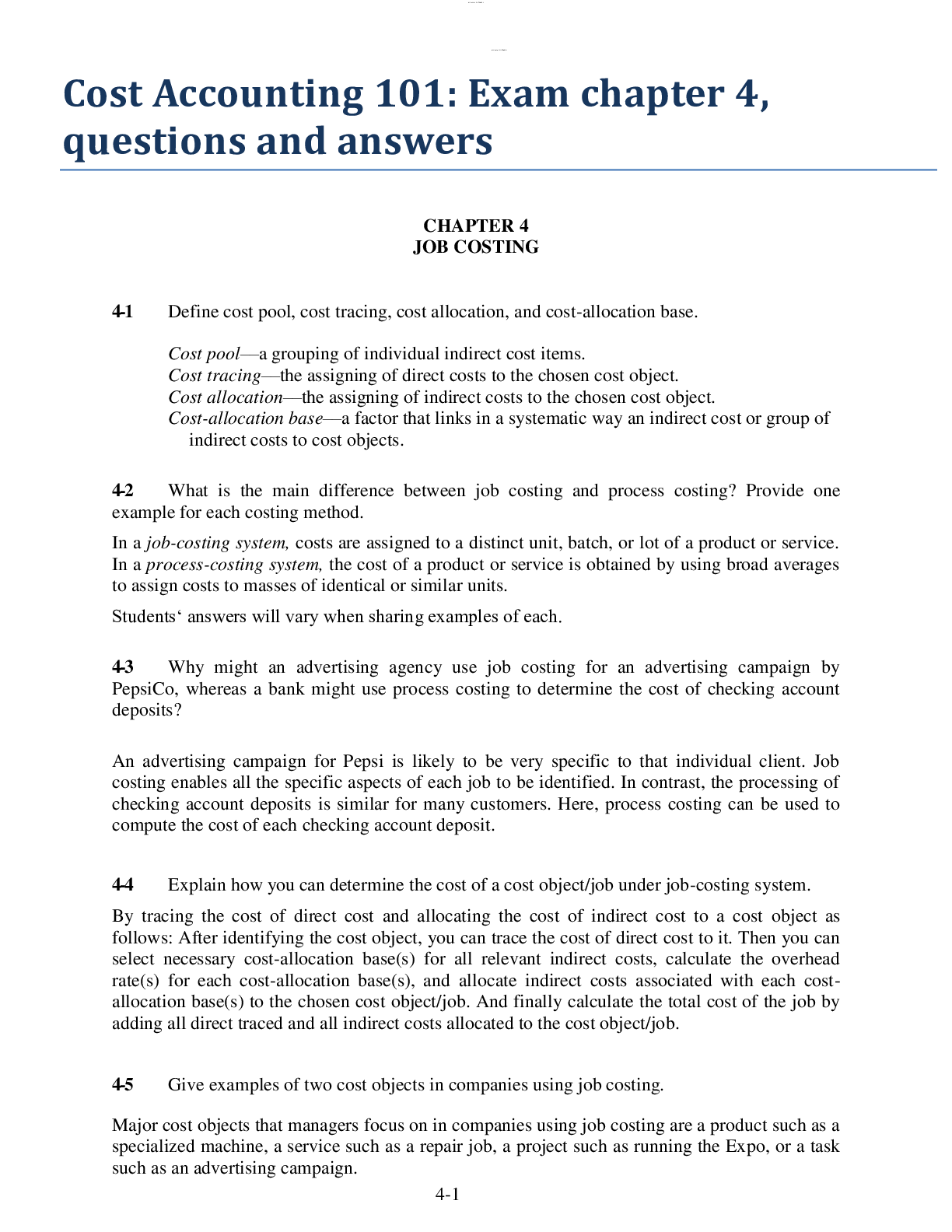
Buy this document to get the full access instantly
Instant Download Access after purchase
Add to cartInstant download
Reviews( 0 )
Document information
Connected school, study & course
About the document
Uploaded On
May 23, 2020
Number of pages
67
Written in
Additional information
This document has been written for:
Uploaded
May 23, 2020
Downloads
0
Views
122



